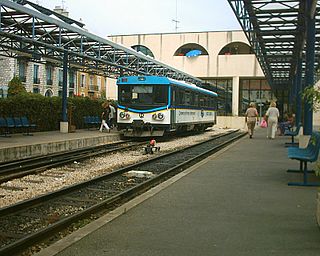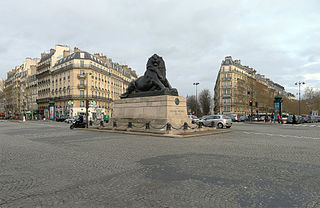
The Paris Métro, short for Métropolitain, is a rapid transit system serving the Paris metropolitan area in France. A symbol of the city, it is known for its density within the capital's territorial limits, uniform architecture and historical entrances influenced by Art Nouveau. The system is 245.6 kilometres (152.6 mi) long, mostly underground. It has 320 stations of which 61 have transfers between lines. Operated by the Régie autonome des transports parisiens (RATP), it has sixteen lines, numbered 1 to 14, with two lines, Line 3bis and Line 7bis, named because they used to be part of Line 3 and Line 7, respectively. Three lines are automated. Lines are identified on maps by number and colour, with the direction of travel indicated by the terminus.

The Réseau Express Régional, commonly abbreviated RER, is a hybrid commuter rail and rapid transit system, similar to the S-Bahns of German-speaking countries and the S Lines of Milan, serving Paris and its suburbs. It acts as a combined city-center underground rail system and suburbs-to-city-center commuter rail. In the city center, it acts as a faster counterpart of the Paris Métro, having fewer stops.

The Ligne de Sceaux was a railway line in France running from Paris, which initially linked the Place Denfert-Rochereau (then called the Place d'Enfer, in Paris, to the town of Sceaux.

Port-Royal station is a French railway station on the RER B line in Paris. It is located in the 5th arrondissement, not far from its tripoint border with the 6th and 14th arrondissements. It is named after Port-Royal Abbey, Paris.

Denfert-Rochereau is a station on the Paris Métro in France. An adjacent station with the same name is served by RER B.

RER B is one of the five lines in the Réseau Express Régional, a hybrid commuter rail and rapid transit system serving Paris, France and its Île-de-France suburbs. The 80-kilometre (50 mi) RER B line crosses the region from north to south, with all trains serving a group of stations in central Paris, before branching out towards the ends of the line.

Line 6 is one of the sixteen lines of the Paris Métro rapid transit system. Following a semi-circular route around the southern half of the city above boulevards built along the path of the former Fermiers généraux wall of 1784–1860, it runs between Charles de Gaulle–Étoile in the west and Nation in the east. A significant part of the route is on elevated tracks.
The Compagnie des chemins de fer de l'Ouest, often referred to simply as L'Ouest or Ouest, was an early French railway company which operated from the years 1855 through 1909.

The Chemins de Fer de Provence is a small rail company providing a daily train service between Nice and Digne-les-Bains in Provence. Their single remaining route, which dates from the 1890s and known locally as the Train des Pignes, is a metre-gauge railway, mostly single-track with passing loops at some stations. Between Pont-de-Gueydan and Saint-Sauveur-sur-Tinée the line runs through the valley of the Var. Most stops are upon request only and some do not have a built platform.

The Place Denfert-Rochereau, previously known as the Place d'Enfer, is a public square located in the 14th arrondissement of Paris, France, in the Montparnasse district, at the intersection of the boulevards Raspail, Arago, and Saint-Jacques, and the avenues René Coty, Général Leclerc, and Denfert-Rochereau, as well as the streets Froidevaux, Victor-Considérant and de Grancey. It is one of the largest and most important squares on the left bank of the Seine.

The Arnoux system is a train articulation system, for turning on railroad tracks, invented by Jean-Claude-Républicain Arnoux and patented in France in 1838. Arnoux was the chief engineer of the Ligne de Sceaux, which was originally built with very tight radii in the area around Sceaux, Hauts-de-Seine.

Bourg-la-Reine station is a railway station on the Sceaux line, located in the town of Bourg-la-Reine, Hauts-de-Seine, France.

Mantes-la-Jolie is a railway station in the town Mantes-la-Jolie, Yvelines department, northwestern France. It is on the Paris to Le Havre railway at the point where the line to Caen and Cherbourg diverges. The station is planned to be the future terminus of the line E of the Réseau Express Régional (RER), on an extension from Nanterre–La Folie station in Paris.

Montreux railway station is the largest of the railway stations serving the municipality of Montreux, in the canton of Vaud, Switzerland.
Jean-Claude-Républicain Arnoux was a French civil engineer known for his invention of the Arnoux system for articulating trains on tight curves. As an entrepreneur he founded and directed the Compagnie de Paris à Orsay, which constructed and operated the line from Paris to Orsay and is now part of the Ligne de Sceaux. It opened on 6 June 1846.

Achères–Grand-Cormier station is a French railway station in Achères, Yvelines département, Île-de-France region. It is the only station on the RER A that is not accessible to people with disabilities.

Émerainville–Pontault-Combault is a French railway station on the Paris-Est–Mulhouse-Ville railway, located in Émerainville, Seine-et-Marne department, Île-de-France region. It bears the name of Pontault-Combault as its territory reaches the south and the west of the building. It serves a district of Marne-la-Vallée.

The Z 23000 was a type of passenger train used by the Compagnie du Chemin de Fer Métropolitain de Paris (CMP).

The MI 79, also known as the Class Z 8100 is a dual-voltage electric multiple unit trainset that is operated on line B of the Réseau Express Régional (RER), a hybrid suburban commuter and rapid transit system serving Paris and its suburbs. The MI 79, designed in the 1970s for the RER B which needed dual-voltage (interconnection) trainsets. They were followed by a derivative version, the MI 84, designed in the 1980s to meet the needs of the RER A line, before reassigned to the RER B in the 2010s.

















